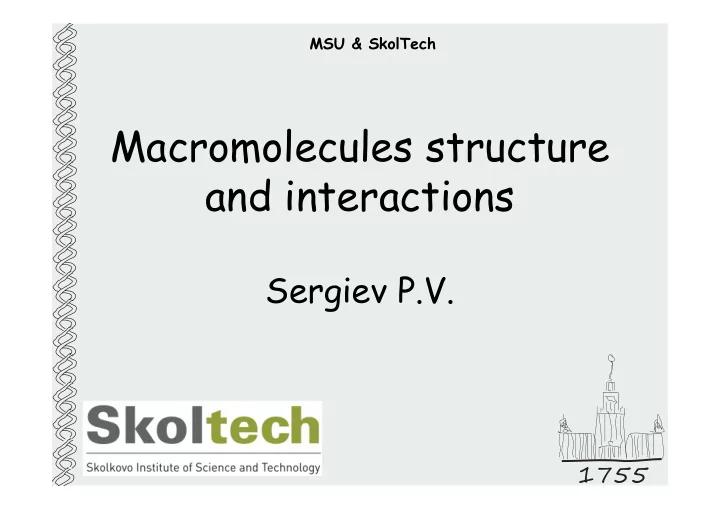

MSU & SkolTech Macromolecules structure and interactions Sergiev P.V. 1755
Structure of macromolecules X-ray structure analysis 1. Purification of macromolecule 2. Crystallization 3. Diffraction 4. Calculation The basement of the method is X-ray beam diffraction ~ Å wavelength 1 1755
Structure of macromolecules X-ray structure analysis beam crystal detector reflections coordinates and intensities are measurable, but phases are required 1755
Structure of macromolecules X-ray structure analysis Method of isomorphous replacement heavy atom Inclusion of a heavy atom, e.g. Hg to the molecule Modified molecule should have the same structure and crystal lattice two cristals ( Max Perutz are needed ) Nobel Prize 1962 1755
Structure of macromolecules X-ray structure analysis Method of multiwavelength anomalous dispersion MAD ( ) selenomethionine Se Utilization of several waivelengths to solve phase problem. No necessity for two crystals 1755
Structure of macromolecules X-ray structure analysis Molecular replacement If similar structure is known 1755
Structure of macromolecules X-ray structure analysis R-factor shows quality of structure calculation = S obs calc |F (h)-F (h)| ______________ R h S obs F (h) h Good R-factor 0.1-0.15 Resolution - ability to distinguish objects located at certain minimal distance resolution 2.1 , = 0.08 Å R 1755
Structure of macromolecules crystallization solvent evaporation temperature drop рН change addition of precipitant ( inorganic salts organic solvents , ) CrystalFarm - 400 plates 96 well screening of the crystallization conditions 1755
Structure of macromolecules Diffraction Usually not in the wet lab, but in the specialized synchrotron facility 1755
Structure of macromolecules X-ray structure analysis PDB - protein data bank (+ nucleic acids +complexes ) >10 0 000 structures Eukaryotic ribosome : 75 chains >3 MDa , 1755
Structure of macromolecules Nuclear magnetic resonance (NMR) For certain nuclei (spin N+ ½ ) projections of spin are quanted spin P = hm (m = I, I-1, ...., -I) z I I for proton +1/2, -1/2 In external magnetic field two projections have different energy magnetic field D n E=h Electromagnetic energy could be absorbed 1755
Structure of macromolecules NMR For available magnetic field intensities corresponding frequencies are hundreds of MHz (radiowaves) Difference in energy is very small in comparison with thermal movement lower level is populated only 0.001-0.07% more E 1755
Structure of macromolecules NMR 1755
Structure of macromolecules NMR factors influencing NMR signal 1. Atoms connected by chemical bonds (chemical shift) 2. Number of atoms, connected through 2-4 bonds (multiplex) 3. Proximal atoms in 3D CH 3 CH 3 O CH 3 CH 2 O CH 3 CH 2 1755
Structure of macromolecules 2D NMR (COSY) CH 3 O CH 3 CH 2 CH 3 O CH 2 CH 3 COSY spectra detects proximity between atoms in CH 3 a chemical structure CH 3 CH 2 CH 2 1755
Structure of macromolecules 2D NMR (NOESY) NOESY spectrum proximity of atoms in 3D p53 1H-1H NOESY spectrum 1755
Structure of macromolecules NMR HSQC Different types of atoms, requires stable isotope labeling 1755
Structure of macromolecules X-ray structure analysis vs. Nuclear magnetic resonance X-ray NMR 1755
Interaction of macromolecules Affinity chromatography: co-purification 1755
Interaction of macromolecules Affinity chromatography: co-purification Requires tagging of one component leads to purification of its partners 1755
Interaction of macromolecules Affinity chromatography: tags for purification GST Immobilized phase is glutathione, glutathione S-transferase as a tag glutathione is used for elution 1755
Interaction of macromolecules Affinity chromatography: tags TAP (tandem affinity purification) tag TEV protein А CBP TAP tag protein immobilized IgG protein TEV protein 1755
Interaction of macromolecules Affinity chromatography: tags TAP (tandem affinity purification) tag protein 2+ Ca protein immobilized calmodulin EGTA protein 1755
Interaction of macromolecules Affinity chromatography: other tags TEV 3X FLAG CBP protein SPA tag ? X myc myc protein HA protein HA 1755
Interaction of macromolecules Affinity chromatography: co- immunopurification by specific antibodies protein G (A) 1755
Interaction of macromolecules Affinity purification of RNA and RNA-protein complexes MS2 coat ZZ protein IgG A A GACCCUUUGGGUACCCGGCUG GG U C CUGGGAAACUCAUGGGCCGGC CC A TEV MS2 coat protein binding site Streptavidin streptomycin (tobramycin) C C A U U G U C C U A C U G G G A C U A A GGA UC G A C U G G U G A C CU A G C U G G G U A C C G A C C C C A G A G G G G C C G G C G C A C A G G U C G G C C G U U Streptomycin G A A A U G A Streptavidin (tobramycin) binding aptamer aptamer 1755
Interaction of macromolecules Yeast two-hybrid system protein 2 Gal4 activation domain protein 1 reporter lacZ ( ) Gal4 DNA binding domain 1755
Identification of interacting parts of macromolecules Deletion analysis 1755
Identification of interacting parts of macromolecules Binding site mutation (scanning mutagenesis) 1755
Identification of interacting parts of macromolecules Cross-linking bifunctional reagent X cleavage X fragment separation and detection of a cross-link X 1755
Identification of interacting parts of macromolecules RNA (DNA) – protein interaction sites Footprinting Modification reagent or nuclease 1755
Identification of interacting parts of macromolecules Binding site mutation (scanning mutagenesis) A C G U K1 K2 K3 RNases T1 G T2 all nucleotides A C,U V1 dsRNA chemical reagents DMS A,C,G(N7) kethoxal G CMCT U 1755
Identification of interacting parts of macromolecules Limited proteolysis protease X 1755
Identification of interacting parts of macromolecules toeprinting DNA polymerase or Reverse transcriptase 1 1 2 3 4 2 3 4 1755
Study of macromolecule interactions Surface plasmon resonance 1755
Study of macromolecule interactions Isothermal titration calorimetry 1755
Recommend
More recommend